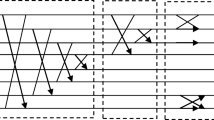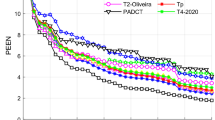Abstract
In mathematical theory, the discrete cosine transform (DCT) is a lossless orthogonal transformation method which means it outputs exactly the same values of the input after the inverse transformation. However, this is impossible in today’s technology due to the limited capacity of processors in which the maximum value that a number can take is \(2^{64} - 1\) (20-digit number) in a 64-bit register. Since the DCT employs the floating values higher than this precision, there occurs a round-off error which causes a particular loss of information after the inverse transformation. For this reason, the dynamic range of the DCT coefficients should be reduced so that fewer precision digits are employed in the DCT calculations, thereby the round-off error and loss of information are minimized. In this study, conventional DCT equations are improved both in forward and inverse transformation for the sake of high-performance JPEG image compression. The proposed method reduces the dynamic range of the DCT coefficients and provides a low dynamic range DCT (LDR-DCT) by weighting the DCT coefficients with respect to the frequency level. The effectiveness of the proposed LDR-DCT method is experimented mainly by observing the inter-correlation between the compression ratio and the peak signal-to-noise ratio (PSNR) values which is defined as the compression performance (CP). An extensive experimental benchmarking study is done using the publicly available KODAK image dataset in both grayscale and RGB color spaces, separately. According to the experimental results, the average compression performance (CP) is increased up to about 26% in grayscale images and about 17% in RGB images when the quantization factors (21–121) are employed in the quantization process. Additionally, it is observed that there is an average increment in the compression performance (CP) up to about 8% in grayscale images and about 7% in RGB images when the standard IrfanView quantization tables (quality level of 40 to the quality level of 90) are applied. On the other hand, in the absence of quantization when either the quantization factor of 1 or the standard IrfanView quantization table with the quality level of 100 is applied, it is also observed that there is an average increment in the PSNR value up to about 15% in grayscale images and about 33% in RGB images with respect to the average PSNR values of 24 images in the KODAK image dataset. Therefore, though the proposed LDR-DCT method without quantization does not change the compression ratio, it improves the quality of the output obtained after the inverse transform dramatically. In other words, the conventional DCT method should be replaced by the proposed LDR-DCT method in certain areas where compression is not required. Besides, the study claims that the proposed LDR-DCT method can provide at least the same JPEG image quality as the conventional DCT method with much higher compression ratios if the quantization tables are redesigned accordingly.



Similar content being viewed by others
References
Pang, C.-Y., Zhou, R.-G., Ben-Qiong, Hu., WenWen, Hu., El-Rafei, A.: Signal and image compression using quantum discrete cosine transform. Inf. Sci. 473, 121–141 (2019)
Dai, J.-Y., Ma, Y., Zhou, N.-R.: Quantum multi-image compression-encryption scheme based on quantum discrete cosine transform and 4D hyper-chaotic Henon map. Quantum Inf. Process. 20(7), 1–24 (2021)
Hussain, A.J., Al-Fayadh, A., Radi, N.: Image compression techniques: a survey in lossless and lossy algorithms. Neurocomputing 300, 44–69 (2018)
Vyas, A., Yu, S., Paik, J.: Fundamentals of digital image processing. In: Multiscale Transforms with Application to Image Processing, pp. 3–11. Springer, Singapore (2018)
Li, M., Zuo, W., Gu, S., You, J., Zhang, D.: Learning content-weighted deep image compression. IEEE Trans. Pattern Anal. Mach. Intell. 43(10), 3446–3461 (2020)
Cai, C., Chen, Li., Zhang, X., Gao, Z.: End-to-end optimized ROI image compression. IEEE Trans. Image Process. 29, 3442–3457 (2019)
Baig, M.H., Torresani, L.: Multiple hypothesis colorization and its application to image compression. Comput. Vis. Image Underst. 164, 111–123 (2017)
Mishra, D., Singh, S.K., Singh, R.K.: Wavelet-based deep auto encoder-decoder (WDAED)-based image compression. IEEE Trans. Circuits Syst. Video Technol. 31(4), 1452–1462 (2020)
Othman, S., Mohamed, A., Abouali, A., Nossair, Z.: Lossy compression using adaptive polynomial image encoding. Adv. Electr. Comput. Eng. 21(1), 91–98 (2021)
Jiang, F., Tao, W., Liu, S., Ren, J., Guo, X., Zhao, D.: An end-to-end compression framework based on convolutional neural networks. IEEE Trans. Circuits Syst. Video Technol. 28(10), 3007–3018 (2017)
Khan, S., Nazir, S., Hussain, A., Ali, A., Ullah, A.: An efficient JPEG image compression based on Haar wavelet transform, discrete cosine transform, and run length encoding techniques for advanced manufacturing processes. Meas. Control 52(9–10), 1532–1544 (2019)
Santos, L., Lopez, S., Callico, G.M., Lopez, J.F., Sarmiento, R.: Performance evaluation of the H.264/AVC video coding standard for lossy hyperspectral image compression. IEEE J. Sel. Top. Appl. Earth Obs. Remote Sens. 5(2), 451–461 (2011). https://doi.org/10.1109/JSTARS.2011.2173906
Sullivan, G.J., Ohm, J., Han, W.J., Wiegand, T.: Overview of the high-efficiency video coding (HEVC) standard. IEEE Trans. Circuits Syst. Video Technol. 22(12), 1649–1668 (2012)
Alshehri, S.A.: Video compression using frame redundancy elimination and discrete cosine transform coefficient reduction. Multimed. Tools Appl. 80(1), 367–381 (2021)
Saha, M., Naskar, M.K., Chatterji, B.N.: Advanced wavelet transform for image processing—a survey. In: Information, pp. 185–194. Photonics and Communication. Springer, Singapore (2020)
Brahimi, N., Bouden, T., Brahimi, T., Boubchir, L.: A novel and efficient 8-point DCT approximation for image compression. Multimed. Tools Appl. (2020). https://doi.org/10.1007/s11042-019-08325-2
Touil, D.E., Terki, N.: Optimized color space for image compression based on DCT and Bat algorithm. Multimed. Tools Appl. 80, 9547–9567 (2021). https://doi.org/10.1007/s11042-020-09754-0
Siddeq, M.M., Rodrigues, M.A.: A novel method for image and video compression based on two-level DCT with hexadata coding. Sens. Imaging 21(1), 36 (2020). https://doi.org/10.1007/s11220-020-00302-6
Gupta, N., Vijay, R., Gupta, H.K.: Performance analysis of DCT based lossy compression method with symmetrical encryption algorithms. EAI End. Trans. Energy Web (2020). https://doi.org/10.4108/eai.13-7-2018.163976
Messaoudi, A., Benchabane, F., Srairi, K.: DCT-based color image compression algorithm using adaptive block scanning. SIViP 13, 1441–1449 (2019). https://doi.org/10.1007/s11760-019-01492-7
Song, H.S., Cho, N.I.: DCT-based embedded image compression with a new coefficient sorting method. IEEE Signal Process Lett. 16(5), 410–413 (2009)
Li, J., Gabbouj, M., Takala, J.: Hybrid modeling of intra-DCT coefficients for real-time video encoding. EURASIP J. Image Video Process. 2008, 1–13 (2009)
Ziad, A.Z., Bellanger, M.G.: Fast DCT-based spatial domain interpolation of blocks in images. IEEE Trans. Image Process. 9(4), 729–732 (2000)
Haweel, T.I.: A new square wave transform based on the DCT”. Signal Process. 81, 2309–2319 (2001)
Alkachouh, Z., Bellanger, M.G.: Fast DCT-based spatial domain interpolation of blocks in images. IEEE Trans. Image Process. 9(4), 729–732 (2000)
Liu, S., Bovik, A.C.: Efficient DCT-domain blind measurement and reduction of blocking artifacts. IEEE Trans. Circuits Syst. Video Technol. 12(12), 1139–1149 (2002)
Tang, J.: A contrast-based image fusion technique in the DCT domain. Digit. Signal Process. 14, 218–226 (2004)
Mukherjee, J., Mitra, S.K.: Enhancement of color images by scaling the DCT coefficients. IEEE Trans. Image Process. 17(10), 1783–1794 (2008)
Cintra, R.J., Bayer, F.M.: A dct approximation for image compression. IEEE Signal Process. Lett. 18(10), 579–582 (2011)
Lina, T.J., Chunga, K.L., et al.: An improved DCT-based perturbation scheme for high capacity data hiding in H.264/AVC intra-frames. J. Syst. Softw. 86, 604–614 (2013)
Jridi, M., Alfalou, A., et al.: A generalized algorithm and reconfigurable architecture for efficient and scalable orthogonal approximation of DCT. IEEE Trans. Circuit Syst. I Regul. Pap. 62(2), 449–457 (2015)
Haweel, R.T., El-Kilani, W.S., Ramadan, H.H.: Fast approximate DCT with GPU implementation for image compression. J. Vis. Commun. Image Represent. 40, 357–365 (2016)
Wang, Y., Xu, C., et al.: DCT regularized extreme visual recovery. IEEE Trans. Image Process. 26(7), 3360–3371 (2017)
Almurib, H.A.F., Kumar, T.N., et al.: Approximate DCT image compression using inexact computing. IEEE Trans. Comput. 67(2), 149–159 (2018)
Oliveira, R.S., Cintra, R.J., Bayer, F.M., Silveira, T.L.T., Madanayake, A., Leite, A.: Low-complexity 8-point DCT approximation based on angle similarity for image and video coding. Multidimens. Syst. Signal Process. 30, 1363–1394 (2019)
An, D., Zhang, S., Lu, J., Li, Y.: Efficient and privacy-preserving outsourcing of 2D-DCT and 2D-IDCT. Wirel. Commun. Mobile Comput. (2020). https://www.hindawi.com/journals/wcmc/2020/8892838/
Zhao, C.,Tong, C.: Research on dct image compression algorithm based on dynamic energy analysis. In: Proceedings of the Int. Conf. on Artificial Intelligence and Advanced Manufacturing, 1–5 (2019) https://doi.org/10.1145/3358331.3358391.
Khalaf, W., Al Gburi, A., Zaghar, D.: Pre and postprocessing for JPEG to handle large monochrome images. Algorithms 12(12), 255 (2019)
Liu, D., Ma, H., Xiong, Z., Wu, F.: CNN-based DCT-like transform for image compression. In: Schoeffmann, K., et al. (eds.) MultiMedia Modeling. MMM 2018. Lecture Notes in Computer Science, vol. 10705, pp. 5–55. Springer, Cham (2018)
Almurib, H.A.F., Kumar, T.N., Lombardi, F.: Approximate DCT image compression using inexact computing. IEEE Trans. Comput. 67(2), 149–159 (2018). https://doi.org/10.1109/TC.2017.2731770
Dagher, I., Saliba, M., Farah, R.: Combined DCT-haar transforms for image compression. Int. J. Imaging Syst. Technol. 28, 274–294 (2018). https://doi.org/10.1002/ima.22286
Strang, G.: The discrete cosine transform. SIAM Rev. 41(1), 135–147 (1999)
https://www.impulseadventure.com/photo/jpeg-quantization.html
Mitchell, J.: Digital compression and coding of continuous-tone still images: requirements and guidelines. ITU-T Recomm. T 81 (1992)
Bharadwaj, N.A., Rao, C.S., Gururaj, C.: Optimized data compression through effective analysis of JPEG standard. In: Proceedings of the 2021 International Conference on Emerging Smart Computing and Informatics (ESCI), pp. 110–115, IEEE (2021)
CCITT Recommendation.: T.81 Int. Tele. Union. Information technology-digital compression and coding of continuous-tone still images – requirements and guidelines (1992)
Bulut, F.: Low dynamic range histogram equalization (LDR-HE) via quantized Haar wavelet transform. Vis. Comput. (2021). https://doi.org/10.1007/s00371-021-02281-5
Ince, I.F., Ince, O.F., Bulut, F.: MID Filter: An Orientation-Based Nonlinear Filter For Reducing Multiplicative Noise. Electronics 8(9), 936 (2019)
Thayammal, S., Selvathi, D.: Multispectral band image compression using adaptive wavelet transform-tetrolet transform. In: Proceedings of the International Conference on Electronics and Communication Systems (ICECS’14), pp. 1–5, IEEE, (2014)
Author information
Authors and Affiliations
Corresponding author
Ethics declarations
Conflict of interest
The authors whose names are listed in this manuscript declare that there is not any conflict of interest among them for this article to the journal, The Visual Computer.
Additional information
Publisher's Note
Springer Nature remains neutral with regard to jurisdictional claims in published maps and institutional affiliations.
Rights and permissions
About this article
Cite this article
Ince, I.F., Bulut, F., Kilic, I. et al. Low dynamic range discrete cosine transform (LDR-DCT) for high-performance JPEG image compression. Vis Comput 38, 1845–1870 (2022). https://doi.org/10.1007/s00371-022-02418-0
Accepted:
Published:
Issue Date:
DOI: https://doi.org/10.1007/s00371-022-02418-0




